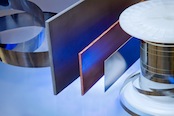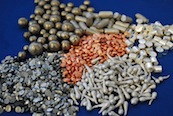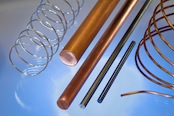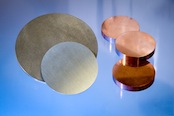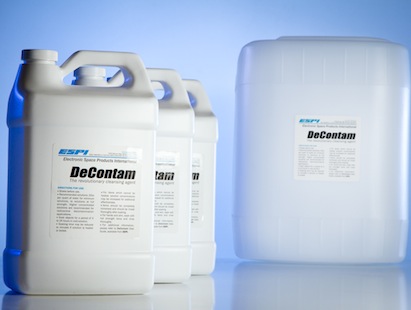Silver Selenide
MATERIAL SAFETY DATA SHEET
I. PRODUCT IDENTIFICATION
Manufacturer/Supplier:
ESPI Metals
1050 Benson Way, Ashland, OR 97520
Toll Free (800) 638-2581 * Fax (541) 488-8313
E-Mail: This email address is being protected from spambots. You need JavaScript enabled to view it.
Product Name: Silver Selenide
Formula: Ag2Se
CAS Number: 1302-09-6
II. HAZARDOUS INGREDIENTS
Hazardous Component: Silver Selenide Silver Compounds
Percent (%): 0-100 0-100
OSHA/PEL: 0.2 mg(Se)/m3 0.01mg(Ag)/m3
ACGIH/TLV: 0.2 mg(Se)/m3 0.01mg(Ag)/m3
HMIS Ratings:
Health: 2
Flammability: 0
Reactivity: 0
III. PHYSICAL DATA
Boiling Point: Decomposes
Melting Point: 880 oC
Specific Gravity: 8.0 g/cc
Solubility in H2O: Insoluble
Appearance and Odor: Gray crystalline solid, no odor
IV. FIRE AND EXPLOSION HAZARDS DATA
Flash Point (Method used): N/A
Autoignition Temperature: N/A
Flammable Limits: Upper: N/A Lower: N/A
Extinguishing Media: Use suitable extinguishing media for surrounding materials and type of fire.
Special Fire Fighting Procedures: Firefighters must wear full face, self-contained breathing apparatus with full protective clothing to prevent contact with skin and eyes.
Unusual Fire and Explosion Hazards: None recorded
V. HEALTH HAZARD INFORMATION
Effects of Exposure:
To the best of our knowledge the chemical, physical and toxicological properties of silver selenide have not been thoroughly investigated and recorded.
The absorption of silver compounds into the circulation and the subsequent deposition of the reduced silver in various tissues of the body may result in the production of a generalized greyish pigmentation of the skin and mucous membranes - a condition known as argyria. The introduction of fine particles of silver through breaks in the skin produces a local pigmentation at the site of the injury. These compounds may be irritating to the skin and mucous membranes. (Sax, Dangerous Properties of Industrial Materials).
Selenium compounds are poison by inhalation and intravenous routes. Some selenium compounds are experimental carcinogens. Long-term exposure may be a cause of amyotrophic lateral sclerosis in humans, just as it may cause "blind staggers" in cattle. Elemental selenium has low acute systemic toxicity, but dust or fumes can cause serious irritation of the respiratory tract. Inorganic selenium compounds can cause dermatitis. Garlic odor of breath is a common symptom. Pallor, nervousness, depression, digestive disturbances and death have been reported in cases if chronic exposure (Sax, Dangerous Properties of Industrial Materials, eighth edition).
Acute Effects:
Inhalation: Dusts or fumes of selenium compounds can cause irritation, metallic taste and a garlic odor to the breath. Silver inhalation may cause mild bronchitis.
Ingestion: May cause gastrointestinal disturbances.
Skin: May cause irritation.
Eye: May cause irritation.
Chronic Effects:
Inhalation: Extreme overexposure to this compound may cause shortness of breath, broncho spasms, chills, fever, headache and delayed pulmonary edema.
Ingestion: May cause chronic selenium toxicity. Large overdoses may cause nervous system disturbances and diarrhea.
Skin: May cause dermatitis.
Eye: No chronic health effects recorded.
Other Effects: Systemic effects of selenium over exposure include pallor, weakness, nervousness and G.I. disturbances. Chronic silver exposure may cause kidney and liver damage.
Routes of Entry: Inhalation, skin
Medical Conditions Generally Aggravated By Exposure: Pre-existing respiratory disorders.
Carcinogenicity: NTP: No IARC: No OSHA: No
EMERGENCY AND FIRST AID PROCEDURES:
INHALATION: Remove victim to fresh air; keep warm and quiet. Give oxygen if breathing is difficult and seek medical attention.
INGESTION: Seek prompt medical attention.
SKIN: Remove contaminated clothing, brush material off skin. Wash affected area with mild soap and water. Seek medical attention if symptoms persist.
EYE: Flush eyes with lukewarm water, lifting upper and lower eyelids, for at least 15 minutes. Seek medical attention if symptoms persist.
VI. REACTIVITY DATA
Stability: Stable
Conditions to Avoid: None
Incompatibility (Material to Avoid): None Recorded.
Hazardous Decomposition Products: Fumes of selenium
Hazardous Polymerization: Will not occur
VII. SPILL OR LEAK PROCEDURES
Steps to Be Taken in Case Material Is Released or Spilled: Wear appropriate respiratory and protective equipment specified in Section VIII- Special Protection Information. Isolate spill area and provide ventilation. Vacuum up spill using a high efficiency particulate absolute (HEPA) air filter and place in a closed container for proper disposal. Take care not to raise dust.
Waste Disposal Method: Dispose of in accordance with Local, State and Federal regulations.
VIII. SPECIAL PROTECTION INFORMATION
Respiratory Protection (Specify Type): NIOSH - approved dust, mist, vapor cartridge respirator
Ventilation: Use local exhaust to maintain concentrations at or below the PEL, TLV. Special: Handle in a controlled, enclosed process. General exhaust is not recommended
Protective Gloves: Rubber Gloves
Eye Protection: Safety Glasses
Other Protective Clothing or Equipment: Protective gear suitable to prevent contamination.
IX. SPECIAL PRECAUTIONS
Precautions to Be Taken in Handling and Storing: Store in cool, dry area. Store in tightly sealed container. Wash thoroughly after handling.
Work Practices: Implement engineering and work practice controls to reduce and maintain concentration of exposure at low levels. Use good housekeeping and sanitation practices. Do not use tobacco or food in work area. Wash thoroughly before eating and smoking. Do not blow dust off clothing or skin with compressed air.
Some of the chemicals listed herein are research or experimental substances which may be toxic, as defined by various governmental regulations. In accordance with Environmental Protection Agency regulations and the Toxic Substance Control Act (TSCA), these materials should only be handled by, or under the direct supervision of, a "technically qualified individual", as defined in 40 CFR 710.29(aa).
The above information is accurate to the best of our knowledge. However, since data, safety standards, and government regulations are subject to change, and the conditions of handling and use or misuse are beyond our control, ESPI makes no warranty, neither expressed nor implied, with respect to the completeness or continuing accuracy of the information contained herein, and disclaims all liability for reliance thereon. Users should satisfy themselves that they have all current data relevant to their particular use.
Issued by: S. Dierks
Date: November 2003

 ALLOYS
ALLOYS 
